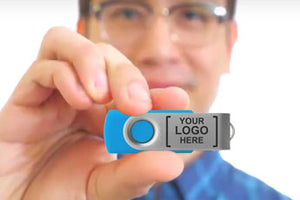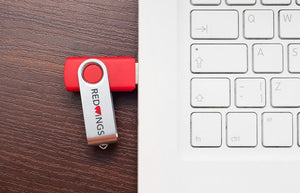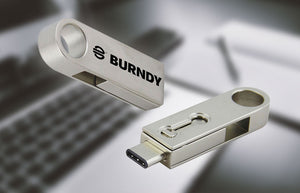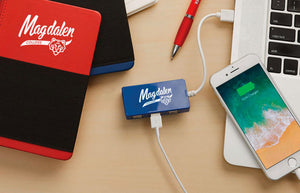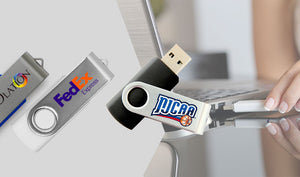How Safe Is Your USB Thumb Drive?
Your USB thumb drive.
It’s a complete lifesaver. A quick, compact device for ferrying around files, it carries your images, music and other data between your home, school, and office.
But have you ever stopped to ask yourself “Just how safe is my USB drive?”
Today, we’ll be putting the security of your USB thumb drive under the microscope, and showing you how you can improve your data security, as well.
How Safe Is Your Thumb Drive?
First off, there’s an inherent risk in carrying any portable storage device.
It might not be likely, but you could lose or misplace it.
While many people might scoff at this idea, the truth is it happens all the time. And the problem is that, because of the size and ease of use of thumb drives, people often store important information on these devices.
Everything from immigration information to a college thesis is easy to keep on you with a thumb drive, and when you lose it, anybody else could pick it up.
It doesn’t stop there.
Because of their popularity, thumb drives have also gotten the attention of hackers in recent years. They have started designing malware and viruses specifically for thumb drives. Users pick them up unknowingly on public computers and only find out once they’ve plugged them in at home and infected their own computers.
By their nature, these are storage devices made to be used on multiple machines. With each computer your thumbstick comes into contact with, however, you run more risk of picking up a virus or trojan.
Another big problem with a USB thumb drive is that having one often encourages people to be slightly lax with their security.
These drives are extremely popular, and you can find them everywhere. While this is convenient, it can be easy to be too comfortable using them.
People often forget to set password protection on these drives. They’ll use them to take data out into the world, lose the drive, and have no protection against strangers opening them.
Remember: Your USB thumb drive is an extension of your hard drive. If you use password protection on your home computer or smartphone, why wouldn’t you use it on your thumbstick?
How To Keep Your Thumb Drive Safe
As we’ve discussed so far, it seems no USB drive is ever 100% safe.
So what can you do to make your information safer when using these convenient little pieces of tech?
The first step is to realize you’re vulnerable to attack and be more mindful of where you use your drive. If you regularly use your drive to ferry your thesis to a computer lab, back it up at home before you head out. If your business information regularly makes the rounds around the office on a stick, never take it home.
Malware and trojans don’t need to exist on grimy, back-alley Internet cafe computers. You could pick one up off of an attachment your kids open on the home computer or a video game download gone wrong. Whatever the case, keep your USB drives away from anything that might compromise them.
Next, use password protection.
This is one of the most overlooked security measures most people can take to safeguard their data. Either use features on your documents to password protect each file, or a USB program to lock the entire stick down. This is a simple precaution, with the potential to save you a lot of trouble if your drive is ever missing or stolen.
Sometimes, burning down the house is the quickest way to clean it. If you suspect your thumb drive is infected with malware, and you can stand to lose your files, you may want to format the whole drive. This is an automated way of clearing all of the information from the stick, whether hidden or not and “starting from zero.”
Keep in mind: Formatting will get rid of literally everything on the drive, so make sure you’re ready before you start.
A Short Word On Safely Ejecting Your Drive
This is a question that’s plagued thumb drive users for as long as the technology has been around.
“Is my computer just being dramatic when it asks me to safely remove my USB drive after using it?”
The short answer is, well, maybe.
There actually is a reason for you to remove your thumb drive the way your PC asks you to, and it has to do with the way it writes information.
When computers transfer data to drives like these, they do it in stages. Say you’re moving a picture to the disk. The machine may move the whole picture right away but, if it has a large transfer of information scheduled in a minute from now, it might wait to do it, then. Or it might do half now, and the rest later. The machine decides on a priority and goes with that, and it often won’t even tell you it’s doing it.
So, when your operating system asks you to safely remove your USB drive, usually the information’s all already there. But, if it hasn’t transferred the information yet, the “Safely Remove” command tells the computer to dump any outstanding data onto the disk. Choosing to forgo this option means running the risk of corrupting your data by leaving the files incomplete.
The Value of a Secure USB Thumb Drive
Given how much they travel, and the way their owners typically approach security, there are a lot of risks to using a USB thumb drive.
That said, there are some simple steps you can take to guarantee the safety of your data. With some caution and a little healthy skepticism, you can avoid tainting your information with viruses or trojans.
Are you in the business of information or just someone with a little data you’re en route with? Take a look at our other articles on flash drives and how you can use them in your business and personal life, today.
CONTACT US
- choosing a selection results in a full page refresh
 Thanksgiving sale! Use code:
Thanksgiving sale! Use code:  Black Friday Sale! Use code:
Black Friday Sale! Use code:  Cyber Monday! Use code:
Cyber Monday! Use code:  Giving Tuesday! For every order we will donate a toy to TOYS FOR TOTS
Giving Tuesday! For every order we will donate a toy to TOYS FOR TOTS
